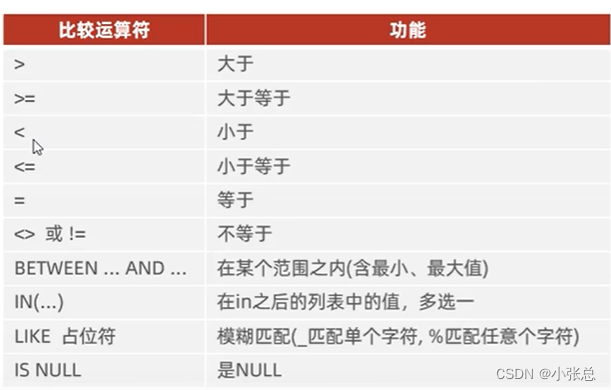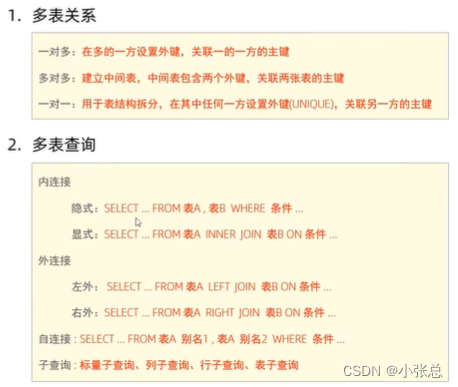一、基本查询
1、查询多个字段
SELECT 字段1,字段2,字段3... FROM 表名;
SELECT * FROM 表名;
2、设置别名
SELECT 字段1 [AS 别名1],字段2 [AS 别名2]... FROM 表名;
3、去除重复记录
SELECT DISTINCT 字段列表 FROM 表名;
1、查询指定字段name,workno,age返回
select name,workno,age from emp;
2、查询所有字段返回
select id,name,gender,age,idcard,workaddress,entrydate from emp;
select * from emp;
3、查询所有员工的工作地址,起别名
select workaddress as '工作地址' from emp;
select workaddress '工作地址' from emp;
4、查询公司员工的上班地址(不要重复)
select distinct workaddress '工作地址' from emp;
二、条件查询
1、语法
SELECT 字段列表 FROM 条件 WHERE 条件列表;
2、条件


1、查询年龄等于88的员工
select * from emp where age=88;
2、查询年龄小于20的员工信息
select * from emp where age<20;
3、查询年龄小于等于20的员工信息
select * from emp where age<=20;
4、查询没有身份证号的员工信息
select * from emp where idcard is null;
5、查询有身份证号的员工信息
select * from emp where idcard is not null;
6、查询年龄不等于88的员工信息
select *from emp where age!=88;
select *from emp where age<>88;
7、查询年龄在15岁(包含)到20岁之间的员工信息
select * from emp where age>=15 && age<=20;
select * from emp where age>=15 and age<=20;
select * from emp where between 15 and 20;
8、查询性别为女且年龄小于25岁的员工信息
select * from emp where gender="女" and age<25;
9、查询年龄等于18或20或40的员工信息
select * from emp age=18 or age=20 or age=40;
select * from emp where age in(18,20,40);
10、查询姓名为两个字的员工信息
select * from emp where name like '_ _';
11、查询身份证号最后一位是X的员工信息
select * from emp where idcard like '%x';
三、聚合函数
1、介绍
将一列数据作为一个整体,进行纵向计算。
2、常见聚合函数

3、语法
SELECT 聚合函数(字段列表) FROM 表名;
注:null值不参与所有聚合函数运算
1、统计该企业员工数量
select count(*) from emp;
select count(idcard) from emp;
2、统计该企业员工的平均年龄
select avg(age) from emp;
3、统计该企业员工的最大年龄
select max(age) from emp;
4、统计该企业员工的最小年龄
select min(age) from emp;
5、统计西安地区员工的年龄之和
select sum(age) from emp where workaddress="西安";
四、分组查询
1、语法
SELECT 字段列表 FROM 表名 [WHERE 条件] GROUP BY 分组字段名 [HAVING 分组后过滤条件];
2、where与having区别

1、根据性别分组,统计男性员工和女性员工的数量
select gender,count(*) from emp group by gender;
2、根据性别分组,统计男性员工和女性员工的平均年龄
select gender,avg(*) from emp group by gender;
3、查询年龄小于45的员工,并根据工作地址分组,获取员工数量大于等于3的工作地址
select workaddress,count(*) from emp where age<45 grounp by workaddress having count(*)>=3;
select workaddress,count(*) address_count from emp where age<45 grounp by workaddress having address_count>=3;
注意:
1、执行顺序:where>聚合函数>having
2、分组之后,查询的字段一般为聚合函数和分组字段,查询其他字段无任何意义。
五、排序查询
1、语法
SELECT 字段列表 FROM 表名 ORDER BY 字段1 排序方式1,字段2 排序方式2;
2、排序方式
ASC:升序(默认值)
DESC:降序
注意:如果是多字段排序,当第一个字段值相同时,才会根据第二个字段进行排序
1、根据年龄对公司的员工进行排序
select * from emp order by age asc;
select * from emp order by age;(asc可以省略)
2、根据入职时间,对员工进行降序排序
select * from emp order by entrydate desc;
3、根据年龄对公司的员工进行升序排序,年龄相同,再按照入职时间进行降序排序
select * from order by age asc,entrydate desc
六、分页查询
1、语法
SELECT 字段列表 FROM 表名 LIMIT 起始索引,查询记录数;
注意:

1、查询第1页员工数据,每页展示10条记录
select * from emp limit 0,10;
select * from emp limit 10;
2、查询第2页员工数据,每页展示10条记录((页码-1)*页展示记录数)
select * from emp limit 10,10;
七、案例
1、查询年龄为20,21,22,23岁的女性员工信息
select * from emp where gender='女' and age in (20,21,22,23);
2、查询性别为男,并且年龄在20-40岁(含)以内的姓名为三个字的员工
select * from emp where gender='男' and (age between 20 and 40) and name like '_ _ _';
3、统计员工表中,年龄小于60岁的,男性员工和女性员工的人数
select gender,count(*) from emp age<60 group by gender;
4、查询所有年龄小于等于35岁员工的姓名和年龄,并对查询结构按年龄升序排序,如果年龄相同按入职时间降序排序
select name,age from emp where age<35 order by asc,entrydate desc;
5、查询性别为男,且年龄在20-40岁(含)以内的前5个员工信息,对查询的结果按年龄升序排序,年龄相同按入职时间升序排序
select * from emp where gender='男' and age between 20 and 40 order by age asc,entrydate asc limit 5;
八、执行顺序

查询年龄大于15的员工的姓名、年龄,并根据年龄进行升序排序
select e.name ename,e.age eage from emp e where e.age>15 order by eage asc;
九、多表关系
1、一对多(多对一)
关系:一个部门对应多个员工,一个员工对应一个部门
实现:在多的一方建立外键,指向一的一方的主键
2、多对多
关系:一个学生可以选修多门课程,一门课程也可以供多个学生选择
实现:建立第三张中间表,中间表至少包含两个外键,分别关联两方主键
3、一对一
关系:一对一关系,多用于单表拆分,将一张表的基础字段放在一张表中,其他详情字段放在另一张表中,以提升操作效率
实现:在任意一方加入外键,关联另外一方的主键,并且设置外键为唯一的(UNIQUE)
十、多表查询
1、连接查询
(1)内连接:相当于查询A、B交集部分数据
(2)外连接:
左外连接:查询左表所有数据,以及两张表交集部分数据
右外连接:查询右表所有数据,以及两张表交集部分数据
(3)自连接:当前表与自身的连接查询,自连接必须使用表别名
2、子查询
十一、连接查询-内连接
1、内连接查询语法
(1)隐式内连接
SELECT 字段列表 FROM 表1,表2 WHERE 条件...;
(2)显式内连接
SELECT 字段列表 FROM 表1 [INNER] JOIN 表2 ON 连接条件...;
内连接查询的是两张表交集的部分

1、查询每一个员工的姓名,及关联部门的名称(隐式内连接实现)
表结构:emp,dept
连接条件:emp.dept_id=dept.id
select emp.name,dept.name from emp,dept where emp.dept_id=dept.id;
select e.name,d.name from emp e,dept d where e.dept_id=d.id;
2、查询每一个员工的姓名,及关联的部门的名称(显式内连接实现)
表结构:emp,dept
连接条件:emp.dept_id=dept.id
select e.name,d.name from emp e inner join dept d on e.dept_id=d.id;
select e.name,d.name from emp e join dept d on e.dept_id=d.id;(inner关键字可省略)
十二、连接查询-外连接
外连接查询语法
(1)左外连接
SELECT 字段列表 FROM 表1 LEFT [OUTER] JOIN 表2 ON 条件;
相当于查询表1(左表)的所有数据包含表1和表2交集部分的数据
(2)右外连接
SELECT 字段列表 FROM 表1 RIGHT [OUTER] JOIN 表2 ON 条件;
相当于查询表2(右表)的所有数据包含表1和表2交集部分的数据
1、查询emp表的所有数据,和对应的部门信息(左连接)
表结构:emp,dept
连接条件:emp.dept_id=dept.id
select e.*,d.name from emp e left outer join dept d on e.dept_id=d.id;
select e.*,d.name from emp e left join dept d on e.dept_id=d.id;(outer可省略)
2、查询dept表的所有数据,和对应的员工信息(右连接)
select d.*,e.* from emp e right outer join dept d on e.dept_id=d.id;
select d.*,e.* from dept d left outer join emp e on e.dept_id=d.id;
十三、连接查询-自连接
自连接查询语法:
SELECT 字段列表 FROM 表A 别名A JOIN 表A 别名B ON 条件...;
自连接查询,可以是内连接查询,也可以是外连接查询
要给表起别名,方便分析是哪一张中的字段,可读性更强一点。
1、查询员工及其所属领导的名字
表结构:emp
select a.name , b.name from emp a,emp b where a.managerid=b.id;
2、查询所有员工emp及其领导的名字emp,如果员工没有领导,也需要查询出来
select a.name '员工',b.name '领导' from emp a left join emp b on a.managerid=b.id;
十四、联合查询-union,union all
对于union查询,就是把多次查询的结果合并起来,形成一个新的查询结果集。
SELECT 字段列表 FROM 表A ...
UNION[ALL]
SELECT 字段列表 FROM 表B...;
1、将薪资低于5000的员工,和年龄大于50岁的员工全部查询出来
select * from emp where salary<5000
union (all)
select * from emp where age>50;
注意:
(1)对于联合查询的多张表的列数必须保持一致,字段类型也需要保持一致。
(2)union all会将全部的数据直接合并在一起,union会对合并之后的数据去重。
十五、子查询-标量子查询
子查询返回的结果是单个值(数字、字符串、日期等),最简单的形式,这种子查询成为标量子查询。
常见的操作符:= < > >= < <=
1、查询“销售部”的所有员工信息
a.查询“销售部”部门ID
select id from dept where name="销售部";
b.根据销售部部门ID,查询员工信息
select * from emp where dep_id=4;
select * from emp where dep_id=(select id from dept where name="销售部");
2、查询表“方东白”入职之后的员工信息
a.查询“方东白”的入职日期
select entrydate from where name="方东白";
b.查询指定入职日期之后的员工信息
select * from emp where entrydate>'2009-02-12';
select * from emp where entrydate > (select entrydate from where name="方东白");
十六、子查询-列子查询
子查询返回的结果是一列(可以是多行),这种子查询称为列子查询。
常用的操作符:IN 、NOT IN、ANY、SOME、ALL

1、查询“销售部”和“市场部”的所有员工信息
a.查询“销售部”和“市场部”的部门ID
select id from dept where name="销售部" or name="市场部";
b.根据部门ID,查询员工信息
select * from emp where dept_id in (2,4);
select * from emp where dept_id in (select id from dept where name="销售部" or name="市场部");
2、查询比财务部所有人工资都高的员工信息
a.查询所有财务部人员工资
select id from dept where name="财务部";
select salary from emp where dept_id=3;
select salary from emp where dept_id = (select id from dept where name="财务部");
b.比“财务部”所有人工资都高的员工信息
select * from emp where salary >all (select salary from emp where dept_id = (select id from dept where name="财务部"));
3、查询比研发部其中任意一个工资高的员工信息
a.查询所有研发部人员工资
select salary from emp where dept_id = (select id from dept where name="研发部");
b.比“研发部”其中任意一人工资都高的员工信息
select * from emp where salary > any (select salary from emp where dept_id = (select id from dept where name="研发部"))
十七、子查询-行子查询
子查询返回的结果是一行(可以是多列),这种子查询称为行子查询。
常见的操作符:= 、<>、IN、NOT IN
1、查询与“张无忌”的薪资及直属领导相同的员工信息
a.查询“张无忌”的薪资及直属领导
select salary,managerid from emp where name="张无忌";
b.查询与“张无忌”的薪资及直属领导相同的员工信息
select * from emp where salary=12500 and managerid=1;
select * from emp where (salary,managerid)=(12500,1);
select * from emp where (salary,managerid)=(select salary,managerid from emp where name="张无忌");
十八、子查询-表子查询
子查询返回的结果是多行到列,这种子查询称为表子查询。
常用的操作符:IN
1、查询与“鹿杖客”,“宋远桥”的职位和薪资相同的员工信息
a.查询“鹿杖客”,“宋远桥”的职位和薪资
select job,salary from emp where name="鹿杖客" or name="宋远桥";
b.查询与“鹿杖客”,“宋远桥”的职位和薪资相同的员工信息
select * from emp where (job,salary) in (select job,salary from emp where name="鹿杖客" or name="宋远桥");
2、查询入职日期是“2006-01-01”之后的员工信息,及其部门信息
a.入职日期是“2006-01-01”之后的员工信息
select * from emp where entrydate>'2006-01-01';
b.查询这部分员工,对应的部门信息
select e.*,d.* from (select * from emp where entrydate>'2006-01-01') e left join dept d on e.dept_id=d.id;
十九、多表查询案例
1、查询员工的姓名、年龄、职位、部门信息(隐式内连接)
表:emp,dept
连接条件:emp.dept_id=dept.id
select e.name,e.age,e.job,d.name from emp e,dept d where e.dept_id=d.id;
2、查询年龄小于30岁的员工的姓名、年龄、职位、部门信息(显示内连接)
表:emp,dept
连接条件:emp.dept_id=dept.id
select e.name,e.age,e.job,d.name from emp e inner join dept d on e.dept_id=d.id where e.age<30;
3、查询拥有员工的部门ID、部门名称
表:emp,dept
连接条件:emp.dept_id=dept.id
select distinct d.id,d.name from emp e,dept d where d.dept_id=d.id;
4、查询所有年龄大于40岁的员工,及其归属的部门名称;如果员工没有分配部门,也需要展示出来
表:emp,dept
连接条件:emp.dept_id=dept.id
外连接
select e.*,d.name from emp e left join dept d on e.dept_id=dept.id where e.age>40;
5、查询所有员工的工资等级
表:emp,salgrade
连接条件:emp.salary>=salgrade.lasal and emp.salary<=salgrade.hisal
select e.*,s.grade,s.losal,s.hisal from emp e,salgrade s where e.salary>=s.losal and e.salary<=s.hisal;
select e.*,s.grade,s.losal,s.hisal from emp e,salgrade s where e.salary between s.losal and s.hisal;
6、查询“研发部”所有员工的信息及工资等级
表:emp,salgrade,dept
连接条件:emp.salary between salgrade.losal and salgrade.hisal,emp.dept_id=dept.id
查询条件:dept.name="研发部"
select * from emp e,dept d,salgrade s where (e.dept_id=d.id) and (e.salary between s.losal and s.hisal) and (d.name='研发部');
7、查询“研发部”员工的平均工资
表:emp,dept
连接条件:emp.dept_id=dept.id
select avg(e.salary) from emp e,dept d where e.dept_id=d.id and d.name="研发部";
8、查询工资比“灭绝”高的员工信息
a.查询“灭绝”的薪资
select salary from emp where name="灭绝";
b.查询比她工资高的员工信息
select * from emp where salary>8500;
select * from emp where salary>(select salary from emp where name="灭绝");
9、查询比平均薪资高的员工信息
a.查询员工的平均薪资
select avg(salary) from emp;
b.查询比平均薪资高的员工信息
select * from emp where salary > (select avg(salary) from emp);
10、查询低于本部门平均工资的员工信息
a.查询指定部门平均薪资
select avg(e1.salary) from emp e1 where e1.dept_id=1;
select avg(e1.salary) from emp e1 where e1.dept_id=2;
b.查询低于本部门平均工资的员工信息
select * from emp;
select *,(select avg(e1.salary) from emp e1 where e1.dept_id=2) '平均' from emp e2 where e2.salary < (select avg(e1.salary) from emp e1 where e1.dept_id=2);
11、查询所有的部门信息,并统计部门的员工人数
select d.id,d.name,(select count(*) from emp e where e.dept_id=d.id) '人数' from dept d;
12、查询所有学生的选课情况,展示出学生名称,学号,课程名称
表:student,course,student_course
连接条件:student.id=student_course.studentid,course.id=student_course.courseid
select s.name,s.no,c.name from student s ,student_course sc ,course c where s.id=sc.studentid and sc.courseid=c.id;
二十、多表查询总结





















 1806
1806











 被折叠的 条评论
为什么被折叠?
被折叠的 条评论
为什么被折叠?








